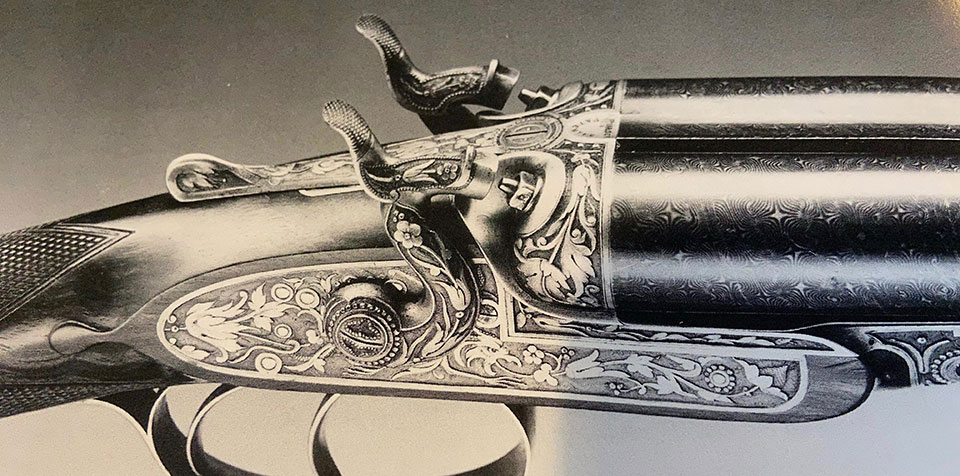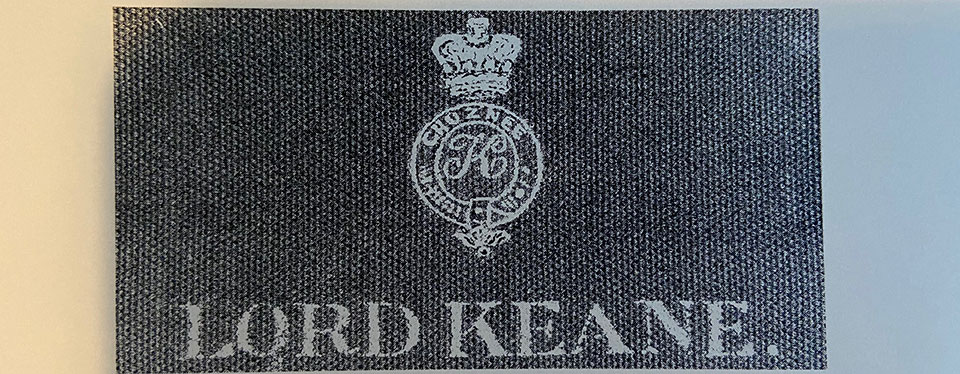As I noted in my previous article, four of the eight guns specifically mentioned in George Sala’s description of Purdey’s exhibit in 1878 eventually ended up in the hands of John, third Baron Keane of Ghuznee and Cappoquin. Today, three are preserved in the Royal Gunroom at Sandringham as part of the ‘Keane Bequest’, together with another ‘chased’ Purdey and four pistols. Purdey’s accounts ledgers describe the transactions of him building this collection, and the story they tell is very different to that which has previously been recorded.
John Manly Arbuthnot Keane was born in 1816, the second son of the first Baron Keane, who had received the title and a pension of £2,000 per annum for his victories during the First Anglo-Afghan War (1839-1842). John also served in the Army, retiring as a Captain in 1848 after thirteen years’ service. After his elder brother, Edward, died on 25 July 1882 without an heir, the title and pension both passed to John, who was then sixty-six, recently widowed, and living on Piccadilly.
Keane does not appear to have had any dealings with Purdey before he inherited the title, but this changed a month after his brother’s death. His account at Purdey opened on 15 August 1882, when he had a Needham gun rejointed and his younger brother’s gun, No. 8682, serviced. He was also loaned a 16-bore hammer gun, No. 10,733, for two months at a cost of 7s 6d. The following year he purchased his own 16-bore, No. 11,387, for £68 5s including case and fittings. This was a bar-in-wood hammer gun with a Purdey thumblever, and was fitted with a varnished maple stock at no extra charge. It was initially quite tightly choked, but was adjusted to a standard game configuration in October 1884.

Keane purchased the first of his exhibition guns that same year; in July 1884. This was No. 9568, the chased 60-bore double rifle Purdey exhibited at both Paris and Sydney. He paid £110, which was only a small discount from the nett price of £112 10s listed at Sydney in 1879. Although he purchased 150 rifle cartridges the following month, it is unclear if they were for this rifle, as he also owned rifles by Jackson and Winchester.
Keane purchased very few shotgun cartridges during this period; only seven hundred between 1882 and 1884. These are tiny numbers by the standard of some of his contemporaries, but given his age it is perhaps not entirely surprising. As further evidence that he was shooting his gun, he even purchased a dozen ‘grouse boxes’ in September.
12,177 is the only gun in the group that was both built for Keane and that can be definitively attributed as Barré’s work.
His spending increased dramatically over the next two years. On his main account, he purchased further leather goods and more cartridges, including six loaded with 1¼oz. of AAA shot in November 1885 – a serious load for a 16-bore! At the beginning of that same month Purdey opened a ‘Separate Account’ for Keane, through which he purchased the four guns that are now at Sandringham. It appears that this was done to allow him to make deposits against his new purchases; usually amounts of £10, once or twice a month. Although his first purchase on this account, for No. 12,177, was only invoiced on 10 November, he had made his first payment on 1 May.
No. 12,177 is the only gun in the group that was both built for Keane and that can be definitively attributed as Barré’s work. The chasing on the action, together with the Whitworth Steel barrels, brought the total cost of the gun to £98. A double case with cover was supplied separately for an extra £7 10s at the same time.

In early December he was invoiced for a set of ‘ivory & gilt fittings’ at £5, and lining of the case, stamping and engraving cost an additional £4 4s 6d, meaning the case and fittings cost a total of £16 14s 6d. He appears to have received a partial refund of £6 14s 6d on 31 December, for a ‘morocco lining case &c not had’, but the accounts are slightly unclear here. A single case survives for this gun in the Sandringham collection, but sadly not all of the fittings are present.
Keane was invoiced for his next gun, No. 9563, on 31 December. This was the chased 12-bore hammer gun that had been exhibited alongside No. 9568 at Paris (for £94 10s nett) & Sydney (£90 nett), including a morocco leather-lined case and ivory fittings. It was patterned in January 1876, meaning that it had been in the company’s inventory for almost a decade by the time it was sold. The records also note that this gun was stocked by Frederick Beesley, although whether this is the work he was given a present of 12s for at the end of 1878 is unclear.
Keane was charged £90 for gun and case, and an additional £3 4s 6d for having his crest and name on the overcase. Part of the invoice for this gun was paid off by selling his brother’s gun, No. 8682, back to Purdey, for a credit of £35. A balance of £38 4s 6d was carried over into 1886, and paid off by the end of April. Both accounts were then dormant until July, when he purchased another morocco-lined case with ivory fittings for £11 4s 3d, but then made no other purchases for the rest of that year on either account.
Keane appears to have shot the 1886 season, as in February 1887 he was invoiced for cleaning No. 12,177 and repairing bruises in the stock. 1887 was also his most active year, with his main account recording the purchase of cartridges and a game licence, as well as begin invoiced for ‘Carriage of Dogs’ on two occasions. On his ‘Separate Account’, he purchased another guncase on 5 April for £11 18s, and his final pair of guns on 14 May, Nos. 10,110/1.
These were maple-stocked 16-bores with gold-inlaid decoration that had also been at the 1878 Exhibition, but unlike the two chased guns were sold, on 24 June 1879, to Timothy Hutchinson for £220. As noted in my previous article, Hutchinson was a prolific buyer in this period, but often sold guns back to the company after only a short period. This pair was not mentioned again until he returned them in March 1887, suggesting that they had seen limited use, and he was credited £120 for them.

They were very similar to No. 11,387, which Keane exchanged for £30 credit on 1 April 1887, putting it towards the £150 he paid for Nos. 10,110/1 the following month. His final purchases on the ‘Separate Account’ were a pair of Chamois leather gun covers, a cartridge carrier, and a ‘Book of arms &c. & 100 plates’, although it is not clear if this was firearms or heraldry-related.
In the two years that Lord Keane’s ‘Separate Account’ was active, he spent a total of £396 12s 6d on the four guns and their accoutrements. Another £112 13s 4d had been charged to his main account over the same period, and at the end of the year just £1 13s 6d was left outstanding. This was paid off in cash the following February, but his spending after this point changed dramatically. His account for 1888 came to just £3 11s 10d, the bulk of which was for five hundred 16-bore cartridges.
The following year he purchased the last of six cartridge carriers, with a canvas cover stamped with his name in gold, for a total cost of £5 6s. By this time, Keane was seventy-two years old, but it is remarkable how suddenly his spending stopped. It would appear to suggest a significant event had occurred, but virtually nothing is known of this period of his life, and so we can only speculate as to what may have been the cause of this change.
At the end of the 1889 his account had an outstanding balance of 2s, which was eventually written off five years later, with no subsequent purchases having been made. When Keane died in November 1901, his estate was valued at £13,185, 16s 1d, equivalent to just over £1million today. In his will, dated 13 July 1899, he bequeathed ‘…To His Royal Highness the Duke of York all my guns pistols canes walking sticks gun cases and cabinets and hunting and riding whips…’
Lord Keane had no known connection to the Royal Family except through his father
This explains why the Sandringham Catalogue notes them as gifted to the Prince of Wales, George having risen to that title after the death of Queen Victoria in January 1901. There is no explanation for this bequest, and Lord Keane had no known connection to the Royal Family except through his father, who had died before George was born. There are also no records of him serving the Royal Family in any capacity, beyond David Baker’s note that he was High Sheriff of County Waterford in 1875. As so little is recorded of Keane’s life, it appears highly unlikely that the connection will ever be understood.
Keane’s will, combined with his accounts, leaves one rifle unaccounted for. No. 9568, the 60-bore double rifle, was never mentioned again after its purchase in 1884, and was apparently not included in the bequest to the Prince of Wales in 1901. Although it may be coincidental, it was also the only one not to be purchased under the ‘Separate Account’.
This raises the question of what that account was intended for, and whether Keane had a longer-term plan for his collection than is immediately apparent. Whatever the reason, as David Baker noted in 1989, his collection of firearms is today preserved as a noted and valuable part of the Royal Gunroom at Sandringham.
Dr Nicholas Harlow is Gunroom Manager at James Purdey & Sons in London.
Published by Vintage Guns Ltd on (modified )




